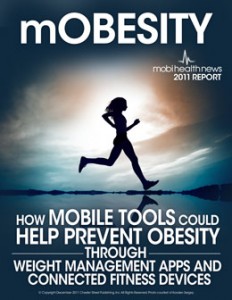 This week MobiHealthNews launched its latest paid research report, mObesity: How Mobile Tools Could Help Prevent Obesity Through Weight Management Apps and Connected Fitness Devices. The report focuses on the news, challenges, and missteps made by some of the highest profile companies offering connected fitness services today. In its 65 pages, mObesity includes a roundup of a couple dozen startups working in the sector; the announced investment activity surrounding connected fitness startups in the past three years; a discussion of mistakes made (and still being made) by the current crop of wellness startups; a review of some of the efficacy and effectiveness studies about connected fitness devices; and much more.
This week MobiHealthNews launched its latest paid research report, mObesity: How Mobile Tools Could Help Prevent Obesity Through Weight Management Apps and Connected Fitness Devices. The report focuses on the news, challenges, and missteps made by some of the highest profile companies offering connected fitness services today. In its 65 pages, mObesity includes a roundup of a couple dozen startups working in the sector; the announced investment activity surrounding connected fitness startups in the past three years; a discussion of mistakes made (and still being made) by the current crop of wellness startups; a review of some of the efficacy and effectiveness studies about connected fitness devices; and much more.
To purchase the full report head over to MobiHealthNews research here. Check out a sneak peek of the report's intro below:
Your ever-smarter mobile phone can’t make you lose 10 pounds. No, mobile phones are not a cure for obesity, the most pressing public health issue facing the United States today. But mobile tools can help.
For many, they already have.
Big name brands, including Nike and Weight Watchers began offering mobile-enabled fitness and dieting tools years ago. Millions of people now use them.
Connected fitness startups and device makers have proliferated in the past few years, launching a wide range of wireless tracking devices and mobile apps. A handful of these apps now boast millions of users, too. With the exception of longterm incumbents like Garmin and Polar, most of the new generation of devices have just recently become commercially available.
Brick-and-mortar stores recently began stocking these new, mobile-enabled fitness devices, which were in many case up until this past year only available through online sales channels. In the past year big box retailers like Best Buy began creating dedicated sections of their stores for health and fitness devices – complete with demonstration pedestals so consumers could become familiar with the devices’ offerings. Apple began stocking some of those same devices in its destination Apple Stores in the past year, too.
Silicon Valley investors have finally woken up to the potential of connected fitness. Many began placing their bets on wellness startups in 2011, many more will announce plays in 2012. By all accounts this sector is flush with investment dollars and interest.
While this new generation of fitness devices has only recently entered the fray, already at least one device maker has had a high-profile flop, which led to a halt in production and blanket refund offer. Others with product in the market are also approaching the market in the wrong away, according to some industry watchers.
Most of the connected fitness services available today present feedback loops in the form of charts and graphs, which may work for a certain subset, but others working in the space believe the service side of these offerings needs to get beyond the data to reach a broader user base.
In 2012 new offerings that avoid terms like “exercise” and other loaded words to encourage and remind people to be active in ways outside of the typical workout. New services recognize that some overweight people are more comfortable finding ways to be active at home. Others are finding ways to reward successful weight loss with free tools that help them lead a community of others like them to similar dieting success.
The next two years will bring a shakeout that leads to consolidation in the connected fitness sector. Failed startups will disband or be rolled up into others that have gained traction beyond early adopters. Following that fallout, larger companies will step up to make acquisitions just as these devices and apps are going mainstream.
Purchase the full mObesity report over in MobiHealthNews' research library here.














